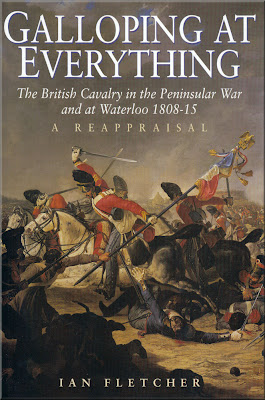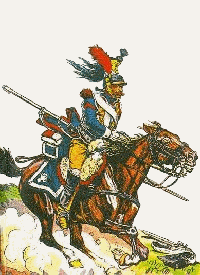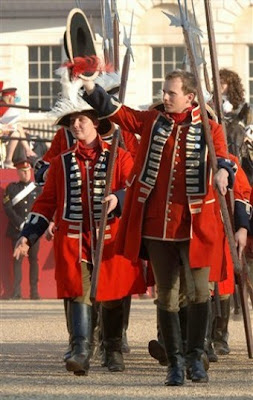I don’t know much about the Battle of Waterloo (every Regency I’ve written has been set earlier, so I’ve never bothered to study it much). So as my part of the Risky Regencies Waterloo week, my post today will talk about the evolution of my cavalry hero in MY LADY GAMESTER — what choices I faced in creating him, and how I worked to weave my research into the story.
I decided early in the planning of this novel that my hero (Lord Stoke, once known as Captain Stanton) was to be an ex-military man. And yes, this concept is quite common in Regency romances — the hero a younger son, career military, who never expected to inherit the title — but this concept is used a lot because it works so well. Talk about conflict! You have a man who is not what he appears to be; you have a fish out of water; you have a man with different priorities, values and tastes than many of the folks now around him.
After deciding Lord Stoke had been an army man (as navy didn’t fit his backstory), I quickly decided he had to be cavalry, as horses would be one of the things that drew him and the heroine together (and also created major problems.)
So then it was: what kind of cavalry? I read a bunch of Haythornthwaite books (some pictured here) and talked to my Trusty Todd (patent pending), and concluded that light cavalry seemed to do more fun things and have a better reputation for usefulness at this point than heavy cavalry, and heavy horses wouldn’t work anyway — so light cavalry it was.
 Next decision: the year, and the hero’s military past.
Next decision: the year, and the hero’s military past.
I needed the Napoleonic Wars to still be going on (poor Stoke, away from the fighting and feeling useless!), but I also needed for a cavalryman who had sold out a year before to have been in the field for several years, and taken part in a few major battles in which light cavalry were involved, and in which there had been a fair number of casualties.
I concluded that Talavera (July 1809, which used two light cavalry brigades) would work for the major battle in which Stoke’s best friend, the redheaded scamp Basty, was wounded…and Albuera (May 1811, one light cavalry battalion) would be suitable for the battle in which poor Basty finally died. So the year of my novel became 1812.
I then studied up on Talavera and Albuera, and also lots of general cavalry and army stuff (their weapons, their tactics, how they trained their men and horses — that sort of thing.)
 And of course, all along, Trusty Todd was at hand to help clarify the differences between a musket, a carbine, and a pistol, to explain what exactly happened when a firearm “misfired” (and to remind me frequently that the Armies of Wellington were kept up the Sleevies of Wellington…)
And of course, all along, Trusty Todd was at hand to help clarify the differences between a musket, a carbine, and a pistol, to explain what exactly happened when a firearm “misfired” (and to remind me frequently that the Armies of Wellington were kept up the Sleevies of Wellington…)
The final hurdle, of course, was writing the scenes in which Stoke explained the battles and their personal significance to my heroine…trying to be clear and correct without boring the reader in the least. Ah, yes, the simple joys of authorhood.
And the end result? See what you think: here’s part of the section in which Stoke tells Atalanta what happened at Talavera:
The memories were perfectly clear. “We were in the middle of a charge, but something had gone wrong. I think the scouts had been misled as to the enemy’s strength. Hard to tell.”
He paused, seeing the smoke and mud all about. “Their artillery had taken a hard toll on us–we didn’t realize how much until after it was all over. But it was obvious that we were disorganized. Sebastian was to my right, on Minerva. We hit the French cavalry hard.”
 He shook his head. “It’s impossible to describe what it’s like, being in the middle of a battle. You can rarely see more than what’s right in front of you. You have a saber slashing down at you, and if you’re lucky, you get there first, or deflect it. Then you strike back, fast. If you succeed, there’s already another horse upon you, another saber, or occasionally a pistol pointed at your chest.”
He shook his head. “It’s impossible to describe what it’s like, being in the middle of a battle. You can rarely see more than what’s right in front of you. You have a saber slashing down at you, and if you’re lucky, you get there first, or deflect it. Then you strike back, fast. If you succeed, there’s already another horse upon you, another saber, or occasionally a pistol pointed at your chest.”
He stared up into the peaceful trees. “All you can hear is the shouting at a charge, the guns, the artillery. The screaming. And there’s smoke all over. It gets in your nose, in your eyes. Dirt, mud. Blood. Horses falling all around.”
But this wasn’t what he’d meant to say. “On top of everything, it was foggy that day. It looked like the plains of hell. Out of nowhere came a French dragoon, his sword covered with blood. He slashed Sebastian before I could shout a warning.”
She gave a distressed cry. “Was he all right?”
He rubbed at the tension in his forehead. “A saber in the face is never a pretty sight. God knows, we disfigured plenty of French, so it was no surprise. But he was all right, yes. Thanks to his mount.”
And…that’s my story!
So…what Regencies have you read where you thought the military stuff was done particularly well?
All answers welcome!
Cara
Cara King, author of MY LADY GAMESTER, a more poetic title than MY LORD DRAGOON

Cara, as I’ve previously gushed here, I love military history in novels. In addition to Heyer’s Infamous Army, Gayle Wilson’s Regencies often had army heroes (sadly, she has given up historicals for contemp romantic suspense.) Then there’s Carla Kelly’s amazing One Good Turn, in which the heroine is a Spanish girl who survived the horrors after the seige of Badajoz. I’ll look forward to more of Captain Stanton!
Don’t check your calendars; it isn’t Tuesday! Cara very graciously offered to take my blog for today because I am still “Galloping” toward my ending…or maybe crawling is a better word. I hit a terrible snag that stopped me cold, but I hope now to press on. My lovely editor, Linda Fildew of HH and Mills & Boon Historicals, gave me another extension.
It kills me not to be a part of Waterloo week. Those bookcovers Cara shows. I’ve read those books! And how lucky she is to have Trusty Todd for instant expertise. I have my monster book room and google. And a husband who can fix any computer glitch, so he’s useful in his own way.
Thank you so much, Cara, for being Diane for a Day!
(and Julia, it is a thrill to have you posting with us!)
Great post! I’m with Julia (and you, clearly), I love military history in my romances (Heyer’s An Infamous Army makes me cry EVERY TIME when she describes the Highlanders marching out).
Cara, a wonderful post. It’s great to see the research you started with, how you drilled down into the details, and what the resultant fiction piece was.
Julia, hi again!
I think Todd should start an online column–Ask Trusty Todd. I think it would be very popular here. 🙂
As far as authors who do battles well, I think that Bernard Cornwell’s Sharpe series is good. Of course it helps to picture Sean Bean in the role — but then, it helps to imagine Sean Bean in just about any setting.
In my opinion one of my best authors at putting you in the middle of the action is Rosemary Sutcliffe. Her novels are generally considered YA and her battle scenes tend to be fairly short, but I think they convey the noise and confusion and fear and courage that occurred when men engaged in hand-to-hand combat. She never served in the military so the technology of war is not emphasized, but she gets the psychology so exactly right.
Susan, I’d definitely second you on Rosemary Sutcliffe. I also think Diana Gabaldon’s amazing battle scenes are the strongest parts of her books (both the Outlander and John Gray series).
Sutcliffe. *sigh* I LOVE her books. Love love love love ’em.
I think you did a fantastic job with Captain Stanton and you are so lucky to have a Trusty Todd!
I usually love military heroes. The one exception is when authors deal with PTSD in too modern a way. I’m sure some men suffered from it and I’m sure that caring families and friends (not to mention sweethearts or wives) helped, but it doesn’t feel realistic to me if it is discussed or dealt with as if there were a general understanding of the malady, support groups, etc… I read a book once in which a heroine advised the hero to talk to a priest about it and that felt anachronistic.
Now I feel like I’ve jinxed myself and I’ll receive the same criticism for my current hero! Back to my glass house…
I usually love military heroes. The one exception is when authors deal with PTSD in too modern a way.
I swear I can’t judge the historical category in an RWA chapter contest without getting at least one of these. If I can practically see the seams where the writer spliced in the wikipedia article or library book on PTSD, my suspension of disbelief flies out the window.
I’m also a fan of many of the authors mentioned here–Bernard Cornwell (of course), Carla Kelly, Diana Gabaldon, to name a few. I also love Mary Jo Putney’s SHATTERED RAINBOWS, which was mentioned earlier in the week.
I usually love military heroes. The one exception is when authors deal with PTSD in too modern a way.
I swear I can’t judge the historical category in an RWA chapter contest without getting at least one of these.
Oh great. I’m writing one of these right now…..I promise I haven’t copied wikipedia though.
Oh great. I’m writing one of these right now…..I promise I haven’t copied wikipedia though.
Don’t worry, PTSD isn’t the issue. It’s just when it’s dealt with in a way that feels anachronistic and out of synch with the values and level of knowledge of the times. Which, based on having read your books, I doubt you’d do.
Thanks for your wonderful comments, everyone!
Julia, as to An Infamous Army, I guess I’m in the middle…I loved the non-fighting bits, but I had great trouble getting through the battle. But I seem to have immense difficulty in visualizing a physical scene from a description (it’s one reason I rarely read mysteries) so I’d guess that’s my problem there.
And Diane — I’m happy to be you for a day! Maybe it’ll rub off on me and I’ll start writing faster… 😉
Amanda, I could see it now: Trusty Todd and his Timpanic Tribe of Tempestuous Terpsichores…
Thanks for the Sutcliffe rec, Susan/DC! I’ve only ever read one of hers, which was set in Roman and post-Roman Britain, IIRC…but I actually still refer to it sometimes, so I should really read more of hers!
Elena, I’m with you on the too-modern thing. I feel the same way about addiction, mental illness, etc — not that they didn’t have them then, or recognize them, or occasionally have ideas we might think are too modern (in fact, IIRC, De Quincey said he thought opium addiction functioned like a disease) — but if you read something where *all* the characters react exactly as they would today, quoting ideas that sometimes have only been popular for two or three decades — that throws me out.
Cara
What Cara didn’t mention is how often when she would ask a question my answer would be “I’m not sure–but I think it’s X, and I know where to look it up.” Still, I guess that’s better than nothing. 🙂
Todd-who-is-trusty
Elena wrote:
I usually love military heroes. The one exception is when authors deal with PTSD in too modern a way.
The existence of PTSD in pre-modern war is actually a really interesting question. While many horrific events have occurred during warfare in all eras, it seems that PTSD is most commonly associated with constant fear and stress over an extended period. Since most pre-modern battles lasted no more than a few days, it seems likely that PTSD was uncommon before the modern era. (Except possibly during long, hard-fought sieges; siege warfare has always been particularly terrible.)
This is supported by the fact that the widespread incidence of “shell shock” in WWI was unanticipated, and it took a long time for the army to figure out how to treat it. The British experimented with “Talking Cures,” based on ideas from psychoanalysis; both Wilfred Owen and Siegfried Sassoon were treated in this way. Some men with PTSD, unfortunately, were treated by being shot for cowardice. PTSD also starts showing up in the fiction of the 1920s; Dorothy Sayers’s Lord Peter Wimsey suffers from it, for example.
There’s a fascinating bit in Robert Graves’s autobiography Goodbye to All That (a wonderful book, BTW) where he talks about how long it took in the trenches before a junior officer was no good anymore, due to the cumulative stress. And how they calculated the acceptable odds of death in, say, taking a short cut through no-man’s-land in order to save time walking a long way through the trenches.
Todd-who-is-giving-other-people-PTSD-by-typing-such-long-comments
Diane, I love being able to participate. I’ve just finally escaped from dial-up into the 21st century; previous to that, it took forever just to get e-mail to load. This is such fun I have to be very disciplined about not staying on-line too long! Esp when you lure me in with Waterloo events…
Great post “Diane for a Day” !!
I love all of these examples you have mentioned. There is a very realistic scene of PTSD in Mary Balogh’s SIMPLY LOVE in which the hero has horrible flashback dreams and his wife handles in it a very sensible and loving way, which is something his family did not do. They tended to try to cover it up and tell him not to think about it. One of the things I liked about that book was the fact that the hero came back from war minus an arm and with some bad scars. I’m not real big on disfigured heroes BUT I think it is very unrealistic to have a hero who has gone through the battles fought in the Napoleonic campaigns without a scratch.
Oh great. I’m writing one of these right now…..I promise I haven’t copied wikipedia though.
Diane, I didn’t mean to make you paranoid. I’m sure you will handle the issue in a historically believable way!
I’ve got a different worry myself. The hero of my current WIP is certainly scarred by wartime events but he isn’t suffering from classic PTSD with all the associated symptoms. I worry that modern readers may be conditioned to expect that of every soldier who’s been through the horror of Waterloo. And as Todd very rightly pointed out, that just wasn’t the case.
Agreeing with Todd–Goodbye To All That is a wonderful book.
I really can’t think of anything constructive to say about the frequent appearance of PTSD in historical romance. To me it seems like a form of war profiteering.
I worry that modern readers may be conditioned to expect that of every soldier who’s been through the horror of Waterloo. And as Todd very rightly pointed out, that just wasn’t the case.
Don’t worry, Elena. Not everyone who has been through a trauma develops PTSD!
I’m not real big on disfigured heroes BUT I think it is very unrealistic to have a hero who has gone through the battles fought in the Napoleonic campaigns without a scratch.
I agree. For my hero-in-progress, I even did something like
this.